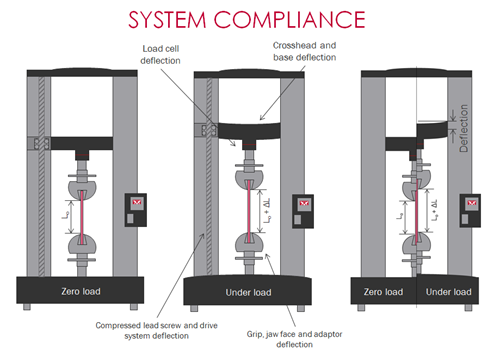A universal testing system very simply measures 2 things during a basic mechanical test: force (via the load cell) and displacement (via the crosshead encoder). To obtain a basic stress-strain curve, you might think that’s all you need. With the force measurement from the load cell, the cross-sectional area of the material can be used to calculate stress; and with the crosshead extension, the original distance between the grips or fixtures can be used to calculate strain throughout the test. How simple!
It may be simple, but it’s not the best option for all material tests. Even when using the proper equipment for your test – machine, load cell, grips, fixtures, etc. – the system is compliant, i.e., it bends and stretches a little bit when you’re running a test! This means that what the crosshead encoder is reading and sending to the software may not truly represent the distance your specimen has traveled. But don’t panic just yet! This is the fundamental reason why we use extensometry in materials tests. An extensometer measures strain directly at the specimen – only taking into account the strain directly at the material, and not anywhere else in the system (the crosshead, the grips, the load cell, the couplings, etc.).

International testing standards will specify if extensometery is required for your testing – so have a look through the standards you follow and make sure you’re using the proper device for your tests. Aren't following a standard? Here are some recommended cases where you should use extensometry:
- Stiff materials (composites, metals, plastics)
- Quality control environments
- Comparing different materials
- Comparing the same material on different machines
- When you want truly accurate strain data!
Note that some extensometers work best for certain materials and situations. If you’re not sure which you should use for your test, we’ll be happy to help you figure it out.